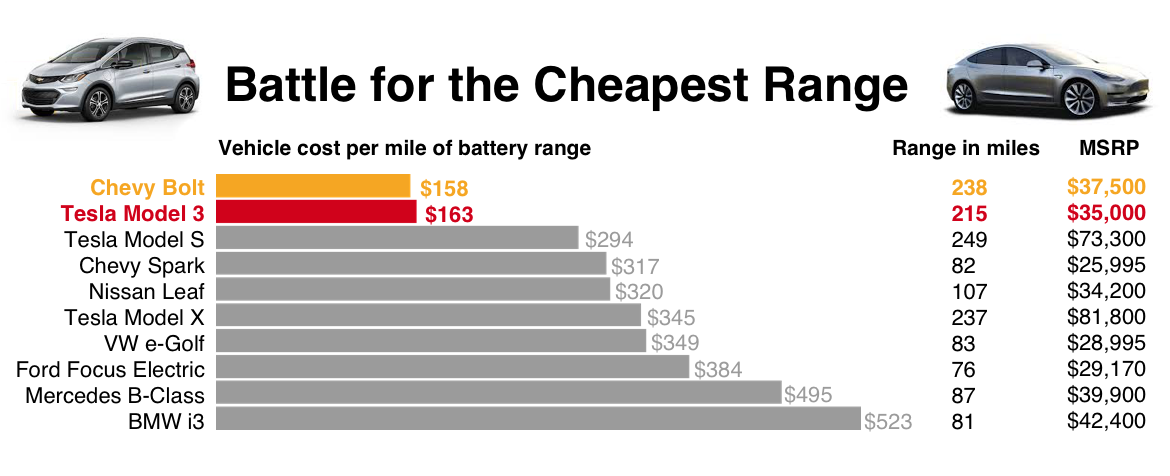Two hundred thirty-eight.
Not so long ago that number would have been unthinkable. When Tesla Motors Inc. rolled out its first electric car, the 2008 Roadster, it boasted what was then a jaw-dropping range of 244 miles on a single charge. It took $110,000 to get your hands on one, but Elon Musk promised that it would usher in an era of long-range affordable cars.
This week a century-old Detroit automaker, General Motors Co., not Tesla, unveiled the latest breakthrough electric car. The 2017 Chevy Bolt and its 238 mile range rivals that of the Roadster and at a third of the price. The Bolt’s $37,500 sticker price isn't exactly “affordable” for the average American buyer, but in terms of range per dollar spent, GM just bested every other electric vehicle on the market, including the full lineup of Teslas.
The chart below breaks down the race for cheap battery range. Until the Bolt goes on sale later this year, the most affordable range goes to Tesla’s Model S, despite the luxury car's $65,000 base price. The big shocker is that the Bolt also edges out Tesla's more affordable Model 3, which doesn't go on sale until late 2017.

Rivals aren’t sitting idle
The Bolt is the most tangible sign yet that traditional carmakers aren't sitting idle. GM, Volkswagen, Ford, and others are each investing billions of dollars in their nascent electric-car programs. Battery prices are falling so fast that EVs may be cheaper, and offer better features, than the average gasoline car within the next five years, according to an analysis we conducted in February. This week, Pierre Andurand, the hedge fund manager who foresaw the 2014 oil crash, warned investors that “After 2020, there is a high risk that electric vehicle penetration will change the oil market forever."
The Bolt shouldn't be counted among Tesla's looming challenges (which are significant). If anything, it's a validation of Tesla's all-or-nothing strategy. One of the biggest differences between GM's approach and Tesla's is that early on, Musk realized that, to bring electric cars to scale, he would also need a massive new supply of batteries. A single Tesla Model S requires the lithium-ion battery power equivalent to thousands of mobile phones, and the world simply doesn't produce enough to power a global fleet of cars. So while Tesla has been learning how to manufacture cars, it's also been working with Panasonic to construct the world's biggest battery factory , which will single-handedly double the world's lithium-ion battery supply.
GM skipped this step and outsourced battery production entirely to its partner, LG Chem. The chemical company, based in Seoul, has done a remarkable job of bringing down the costs of battery packs for GM, but it has nowhere near the 35 gigawatt hours of annual battery production that Tesla's $5 billion Nevada Gigafactory is projecting by 2018. Even if the Bolt were somehow to capture the sort of interest generated by Tesla's Model 3—which has collected almost 400,000 deposits—it's not clear how GM and LG Chem could deliver them.
It’s still not a Tesla
Above a certain threshold, small differences in range aren't how a car is judged, even an electric one. Tesla's Model 3 offers quicker speeds, a sexier design, and such industry-leading options as Autopilot, all-wheel-drive, battery upgrades, towing capability, and a crucial network of more than 700 Supercharging stations that will charge a car in half the time a Bolt owner could hope for. While the Bolt's 238 miles of range is more than enough for the daily commuter, anyone taking a long road trip will suffer without Supercharger access.
GM has some cool new features, too—an innovative rearview mirror, a very functional touchscreen dash—but comparing this year's Bolt to next year's Model 3 is a bit like comparing the Ford Focus to the BMW 3 Series. They're not in the same class. With a manufacturing scale that dwarfs Tesla's, GM has the ability to build a truly affordable mass-market electric car, or one that challenges Audi and BMW. The 2017 Bolt is neither.
Still, GM's Tesla-beating range for an affordable car creates the same sort of shine that elevated the Tesla brand. Just last month, Musk upgraded his luxury models, the Model S and Model X SUV, to claim bragging rights for the first electric cars to surpass 300 miles of range, and he added just enough acceleration to beat out Ferraris and Lamborghinis with the quickest car in the world. At the initial unveiling of the Model 3 in March, Musk vowed, "You will not be able to buy a better car for $35,000, or even close."
Musk isn't likely to let GM's range victory stand unchallenged. Just as Chevy had initially described the Bolt as having a range of "a minimum of 200 miles," only to exceed that number later by almost 20 percent, the Model 3's range unveiled in March may similarly be a placeholder. "The range will be at least an EPA rating of 215 miles," Musk said at the time. "I want to emphasize that these are minimum numbers—we hope to exceed them."
Regardless, if you care about electric cars—and you should —this new milestone by GM is great news. Tesla has defined itself by making constant improvements to its range, prices, and features. GM has a long history of doing the same. This isn't the end of the race for electrification; it's the starting line.
This article was provided by Bloomberg News.